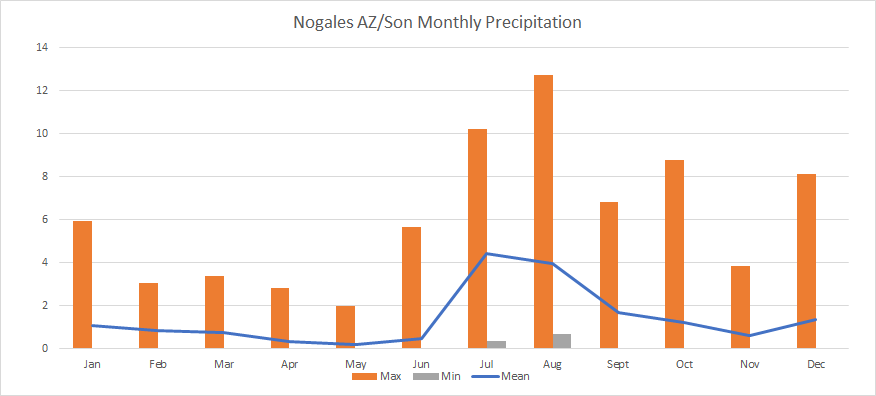Water Harvesting - Details
In Ambos Nogales, water harvesting has taken the form of constructing earthworks, gardens, and trenches to slow and control the flow of water. It also has involved installing gutters on roofs and collecting rainwater in cisterns. The dynamic nature of Nogales, fueled by a monsoon climate, urban growth, and irregular development, creates challenges for developing lasting and effective water harvesting initiatives. Nevertheless, civic organizations, community leaders, and educational institutions in Nogales continue to explore water harvesting and its potential to address some of the region’s serious water issues.
How does it work?
Water harvesting is the process of diverting, collecting, and storing rainwater from surface runoff and effectively using the water for beneficial purposes. The most critical aspect of water harvesting is planning. Efficient water harvesting systems are constructed only after observing topography, calculating catchment area, and careful planning. A catchment area is any surface that allows water to run off, such as roofs, parking lots, sidewalks, and soil. The amount of water that can be captured depends on the size of the catchment area and the material of the surface. In addition, greater slopes lead to faster runoff, so hilly areas create greater challenges than do gently sloping ones.

The Sonora Permaculture Teachers Guild highlights seven principles for water harvesting:
- Manage water at the top of the watershed
- Create multiple microbasins
- Collect, slow, and infiltrate water
- Prepare for overflow
- Use mulch to reduce evaporation
- Put harvested water to beneficial use
- Observe and adjust your systems as needed
An introductory guide to water harvesting in Ambos Nogales provides additional information about these principles and step-by-step details for designing and installing both passive and active systems.
Is passive water harvesting feasible in Nogales?
Key challenges facing passive water harvesting in Nogales are the region’s hilly topography and rapid expansion of the built environment which alters the topography and therefore the flow of water. Capturing water efficiently requires understanding the topography, catchment area, and water flow across all the surfaces in the area. The most successful projects begin at the highest point of the watershed and manage water flow to the lowest point. Following this practice helps prevent erosion and reduces the need for managing large volumes of water at the lowest points.
Is active water harvesting feasible in Nogales?
A central goal of many projects in Nogales, Sonora has been to make water harvesting available to households, small businesses, and community organizations with few resources. With these goals in mind, several types of active water harvesting systems have been constructed in Ambos Nogales. All the systems use gutters, downspouts, and large tanks for storing rainwater. Following a model common in the United States, an early system installed at a Nogales, Sonora residence was constructed from a culvert on a cement base. The lack of locally available culverts and the common local practice of using large plastic water tanks for storage led to a shift in design.

Despite these changes, several challenges remain for individuals and organizations seeking to harvest rainwater in Ambos Nogales. Water harvesting is easiest to manage when rainwater falls in a steady pattern throughout the year because both passive and active systems can be sized to handle the incoming rain. The monsoon climate of the Arizona-Sonora region requires systems that can slow and collect large quantities of water in short periods of time and then make it available—from within the soil or storage tanks—during periods with little or no rainfall. Large systems cost more money than small ones, creating additional challenges for individuals and organizations trying to gather sufficient financial resources and obtain the materials necessary for installing their systems.

Even with the financial resources to undertake a water harvesting project, lack of availability of materials and irregularities in building construction create additional challenges. For example, specialized system elements, such as a first flush system, may be difficult to obtain and, when ordered from outside the region, may require gutters and pipes of sizes uncommon in local stores. Adapting system design to accommodate those elements can significantly increase the cost of the systems. In addition, some structures have been unable to support active systems because of problems installing gutters on uneven or unstable roofs.
Harvested rainwater can be used to water individual plants and gardens. If an active water harvesting system does not have a first flush system, care should be taken in putting water directly on plants to avoid stressing the plants when they come in contact with contaminants that have been picked up by the rain as it flowed into the tank. Rainwater should not be used for human consumption unless it is passed through an appropriate filter.
Benefits
- Water harvesting systems provide a water source for your plants/garden
- Can reduce your water bill household (if there is sufficient rainfall)
- Reduces flooding and erosion
- Reduces the demand on groundwater, overall more sustainable for the environment
Limitations
- Water harvesting systems work best in areas where there is a significant amount of rainwater
- Requires regular maintenance
- Has an initial high installation cost
- Requires significant free space for installation
Additional Resources
- An Introductory Guide to Water Harvesting in Ambos Nogales - This 20-page guide explains what water harvesting is and how to install water harvesting systems, and provides a list of water harvesting resources.
- Guide to Native Vegetation of Ambos Nogales - This informative guide describes the unique ecology of Nogales, Arizona and Nogales, Sonora. Featured are photographs and descriptions of the native grasses, shrubs, trees, wildflowers, and cacti growing throughout the region. These plants can be used as part of water harvesting and revegetation projects.
- Composting Toilets and Water Harvesting: Alternatives for Conserving and Protecting Water in Nogales, Sonora